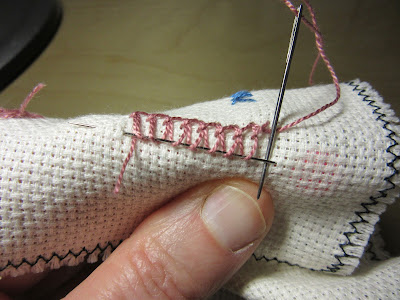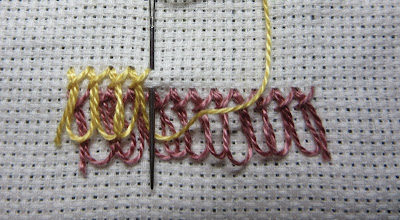One part of learning is to accept and endure things you encounter and find you do not like. Of course, you have the choice to give up or skip a subject you dislike, anyway in free education and when you study by yourself!
On the other hand, if you choose to plod on, you a) will know for sure you dislike the subject matter, b) may learn to like it after all, and c) you will definitely have the right to feel proud that you fulfilled what you had set out to do.
Naturally, all this applies to embroidery and new stitches, too.
Today we have a stitch I have to admit I do not like. It is a canvas stitch with loops - Surry Stitch. I found it in two of my books, The Embroidery Stitch Bible and Mary Thomas's Dictionary of Embroidery Stitches.
Basically, it is an easy stitch, if you keep two things in mind.
1. The needle goes in two directions, up to down,
and right to left.
2. The needle always goes on top of the working thread:
Keeping those things in mind can't be that hard.
So what makes the stitch so troublesome? Well, it's all about tension and thread length. You have to try to keep every loop even in length.
Here is my photo instruction:
Start with a vertical stitch.
Leave a tail.
Pull the tail downward.
Make a horizontal stitch
over the working tread
The first stitch is complete. Easy-peasy!
Make another vertical stitch.
NOW, form a LOOP the length
of the tail, and make the second
horizontal stitch.
You have made your second stitch.
Repeat.
When you reach the end of your
stitching line, cut the thread,
leaving a tail.
The Surry Stitch is neat and tidy on the back.
A second row is worked just above the first. Now you have the old loops as well as the new ones you are going to form to keep in check!
For clarity, I worked them in yellow.
Homework:
Apart form adding to the usual three samplers, try to find a way to stitch evenly!
Leave some loops as they are and cut open some, comparing the different looks.




















































